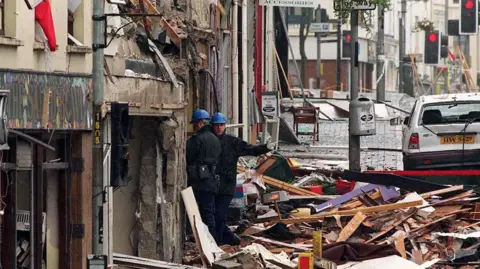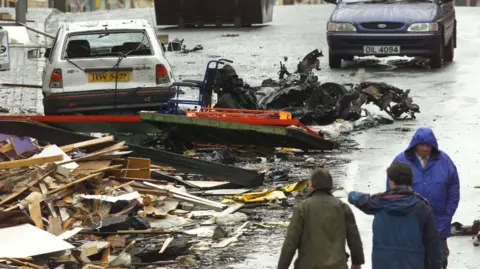 BBC
BBCThe sister of a teenager who was killed in the Omagh bombing believes the conclusion of the inquiry will bring out “a very diluted version of the truth”.
Claire Hayes, whose brother Alan Radford was killed in the bomb when he was 16, said she was sceptical of the outcome of the inquiry due to what she believes is a lack of transparency from government bodies.
The attack, carried out in 1998 by the Real IRA (RIRA), was the biggest single atrocity of the Troubles in Northern Ireland, killing 29 people.
Ms Hayes will address the inquiry on Wednesday.
‘Need complete transparency’
 Pacemaker Press
Pacemaker PressSpeaking to BBC’s Good Morning Ulster on Wednesday, Ms Hayes described her brother Alan as “the most innocent, purest, kindest human”.
“It pains me so much to know he died alone on the street in such a barbaric way,” she said.
Ms Hayes believes the families will get a conclusion as to whether the bomb could have been stopped but doubted that the full truth will emerge.
“There are too many redactions that can be made, there are too many protections in place for the likes of MI5 or informants or whoever,” she continued.
“When the Irish government isn’t partaking in it, it’s not a full inquiry so for me there’s already a flaw.
“We need complete transparency from the southern government.”
She added that while the Irish government has said it will help “they’re not compelled to do so and, for me, for Alan, that’s not something I wanted”.
“I wanted it to be completely robust and completely transparent for him so we know absolutely everything.”
Taoiseach (Irish prime minister) Micheál Martin said on Tuesday that he has made it “very clear” that the Irish government must cooperate fully with the inquiry.
Tánaiste (deputy Irish prime minister) Simon Harris said the Irish government will “not be found wanting”.
He said that the “cross-border nature of the assistance, to an inquiry established under UK law, means that it takes some work to get the details of the mechanisms of cooperation right, but we are actively engaging in this work”.
On Tuesday, the inquiry opened with its chairman Lord Turnbull stating he was “shocked at the level of grief” imposed on bereaved families and survivors.
The names of those murdered in the attack were read out and a minute’s silence observed at the commencement session.
 STR
STRDay one of the inquiry heard tributes to two Spanish victims of the bombing.
Paul Greaney KC, senior counsel to the inquiry, said the statements and personal testimony were a key starting point in the inquiry.
Earlier, Michael Gallagher, who lost his 21-year-old son Aiden in the attack, said he was “grateful that the victims are centre and front and a voice will be given to them”.
“I think it’s important the world knows the type of people we lost in Omagh that day,” he said.
The inquiry seeks to determine whether the bombing could have been prevented by UK state authorities.
This phase of the inquiry, at Strule Arts Centre in Omagh, will last four weeks and is also hearing evidence from survivors and first responders.
The Irish government has promised to co-operate with the inquiry – the bombers launched the attack from across the border.
Dublin previously indicated there was no new evidence to merit a separate public inquiry in the Republic of Ireland.
What was the Omagh bomb?
The Omagh bomb exploded in the town centre on a busy Saturday afternoon on 15 August 1998.
The streets were packed with shoppers, including families who were buying uniforms and other supplies as children were due to return to school after summer.
The attack took place four months after the signing of the 1998 Good Friday Agreement.
Also known as the Belfast Agreement, the international peace deal helped to bring an end to 30 years of violence in Northern Ireland, known as the Troubles.
The treaty had ushered in a period of hope and optimism but not everyone involved in the conflict supported the outcome of the peace talks.
The RIRA – a dissident republican paramilitary group – disagreed with the decision of the much larger Provisional IRA to call a ceasefire ahead of the talks.
It set up its own faction and continued to plant car bombs in towns across Northern Ireland, some of which exploded causing multiple injuries.
But the Omagh bomb was by far the RIRA’s most deadly attack.
Nine children, including a baby, were among the dead.
More than 200 other people were wounded, some of whom survived with life-changing injuries.
Who carried out the Omagh bomb?
Three days after the 1998 attack, the Real IRA released a statement claiming responsibility for the explosion.
It apologised to “civilian” victims and said its targets had been commercial.
Almost 27 years on, no-one has been convicted of carrying out the murders by a criminal court.
A handful of men have been prosecuted on charges linked to the attack but each of them were either acquitted or had their convictions overturned on appeal.
With no criminal convictions secured, the victims’ families then began a landmark civil case, suing five men they alleged were involved in the bombing.
In 2009, the judge in that case ruled four of the men – Michael McKevitt, Liam Campbell, Colm Murphy and Seamus Daly were all liable for the Omagh bomb.
The four men were ordered to pay a total of £1.6m in damages to the relatives, but appeals against the ruling delayed the compensation process.
A fifth man, Seamus McKenna, was acquitted in the civil action and later died in a roofing accident in 2013.
Michael McKevitt, who was alleged to have been the leader of the Real IRA at the time of the bombing, died in 2021 having been diagnosed with cancer.
He had spent 15 years in jail after an Irish court convicted him of directing terrorism, a new offence introduced by the Irish government in response to the Omagh bomb.
Colm Murphy, originally from County Armagh, was jailed for 14 years in 2002 when a Dublin court found him guilty of conspiracy to cause the Omagh bombing.
However, his conviction was ruled to be unsafe in 2005 and he was cleared of the charge in a 2010 retrial.
He died in hospital aged 70 in 2023.
In 2016, a case against Seamus Daly, from Jonesborough, County Armagh, collapsed.

